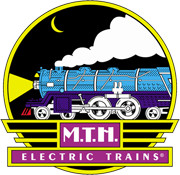Available Items

November 17, 2010 - If there were a Locomotive Hall of Fame, the Pennsylvania Railroad GG-1 would surely be one of the first inductees. Built from 1934 through 1943, the GG-1s' stats were superior to virtually any locomotive of their era, and they still look impressive today. Horsepower: 4,620. Short-term horsepower (available for starting a heavy train): 8,500. Top speed in regular service (with 18 Pullmans in tow): 90-100 mph. Acceleration: zero to 100 in 65 seconds, faster than almost any steam locomotive. Fleet size: 139 engines, more than any other American electric fleet. Service life: Forty-nine years in regular mainline service, 1935-1983, more than any other American locomotive design. Many GG-1s racked up more than five million miles.
To see the locomotive in action, click on the video link above and to the left.
M.T.H. Electric Trains first released the GG-1 in 2008. A limited supply of this magnificent 1:32 scale locomotive is still available at significantly reduced prices. If you've ever wanted to own a beautiful One Gauge locomotive but felt the prices were just out of reach, now is your opportunity! We've reduced the price of the GG-1 to just 499.95. That's a savings of $300.00!!. But hurry, deals like this don't come around very often. At these prices, the remaining GG-1's will sell out quickly.
More About The Prototype
Early in the twentieth century, the Pennsylvania Railroad - the self-proclaimed Standard Railroad of the World - made the nation's largest commitment to multi-track, mainline electrification, from New York City to Washington, D.C. and westward from Philadelphia to Harrisburg, PA. For more than two decades, the PRR experimented with locomotive designs in search of a passenger electric for high-speed mainline service. That search ended in 1934 with the GG-1, a cooperative effort by the PRR, Baldwin, Westinghouse, and General Electric, based largely on neighbor New Haven's successful EP3 juice jack. Industrial designer Raymond Loewy cleaned up the original riveted body to create a design that looked contemporary for half a century.
For five decades the GG-1 fleet hustled passenger traffic of all types, including the famed Congressional and Broadway Limited. A number of GG-1s were also regeared for freight service. Run as double-headers, a pair of them could provide about the same continuous tractive effort as a Union Pacific Big Boy, with virtually no noise, no smoke, much less wear on the track, and significantly less maintenance.
More About The Model
The RailKing One Gauge GG-1 is the most fully-featured, fun-to-operate GG-1 in one gauge. Built to full 1:32 scale proportions, the RailKing GG-1 captures the sounds, the power, and the drama of the Pennsy's premier electric. Proto-Sound® 2.0 provides an authentic GG-1 horn and bell, cooling fan sounds, crew talk, and station announcements for actual Pennsylvania name trains. Pantographs slowly raise and lower each time you change direction, ensuring the rear pantograph is always up. The train heat boiler emits periodic bursts of smoke. Speed control provides the same smoothness as the prototype, at speeds from 3 scale miles per hour to full throttle. Enjoy the M.T.H. GG-1 in five authentic paint schemes, including Raymond Loewy's original pinstripes, the single broad stripe introduced in 1955, and Amtrak's 1975 passenger scheme.
Automatic Pantograph Operation Explained
Users operating the GG-1 in conventional mode will find that by depressing the transformer's direction button to stop the locomotive, the rear pantograph will remain in the up position while the lead pantograph slowly rises up. Once the lead pantograph is in its up position, the rear pantograph will slowly lower into the down position. At this point another press of the direction button will cause the locomotive to reverse making the lead pantograph now the rear pantograph and in the up position.
In command operation two operating modes are offered; auto and manual. Auto mode will behave similar to conventional mode with the rear pantograph in the up position when moving. The up and down movement of the pantograph will be direction controlled using the DCS Digital Command Control System. In Manual mode, the user will have to raise and lower both pantographs via the DCS System as they wish regardless of directional state.






